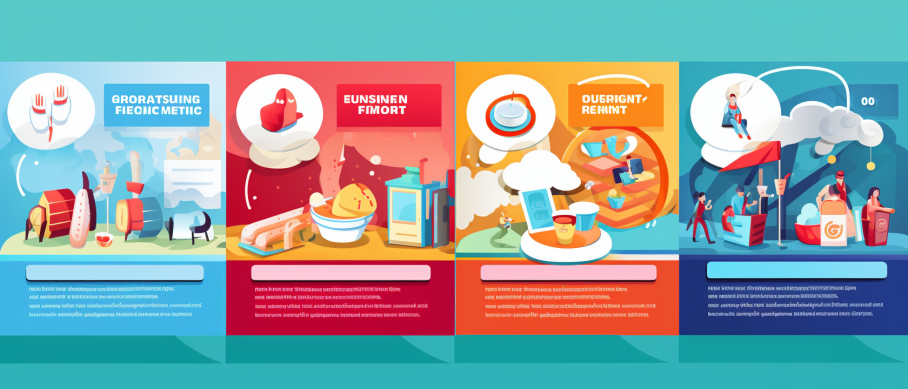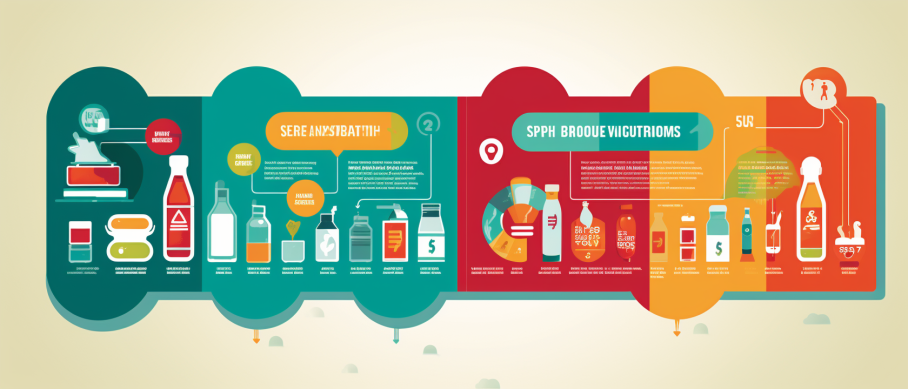Key Takeaways
✅ The 4 Ps of marketing are crucial to understanding and executing an effective marketing strategy.
✅ Defining the product or service in a way that is clear and resonates with the target audience ensures immediate understanding and appeal.
✅ Setting the right price is a balancing act that takes into account production costs, market demand, and competitive pricing.

Introduction
In the captivating world of marketing, success often hinges on a fundamental framework—the 4 Ps. This cornerstone concept, also known as the marketing mix, provides businesses with critical lenses through which to scrutinize and strategize their market offerings. Whether you're a startup entrepreneur or a seasoned marketer, harnessing the power of the 4 Ps is pivotal in navigating the competitive commercial landscape.
Let's embark on a journey to unravel these pillars one by one, charting a course to ensure your product or service not only reaches its intended audience but resonates with them profoundly
Product: Definition and Impact
Defining the product or service being promoted is critical. The language used to describe it should be straightforward, avoiding technical jargon unless the target audience is highly specialized. For products, it is not only what the product does that matters, but also the greater impact it has on society and the environment.
- Clarity: Describe the product in clear terms (e.g., "A moisturizing skin care product that also fights blemishes.")
- Benefits: Explicitly state how the product will improve the customer's life (e.g., "Ensures healthy, radiant skin that feels hydrated all day.")
- Positive Impact: Align the product with societal and environmental values (e.g., "Our skin care product is made with ethically sourced, organic ingredients that support environmental sustainability.")
- Statistical Relevance: Keeping in mind that 76% of consumers expect brands to positively impact society and the environment, highlight any eco-friendly or socially responsible aspects of the product.

Price: Competitive and Valuable
Price is a critical aspect of the marketing mix and can be the deciding factor for many consumers.
- Cost-Based Pricing: Set a price that covers production costs and provides a satisfactory profit margin.
- Market Research: Research competitor pricing to ensure the price is aligned with the market expectations.
- Value Proposition: Justify the price with the value provided, especially if the product has premium features.
- Attractiveness: Ensure the pricing structure is attractive to the desired target audience, possibly through discounts or deals.
- Statistical Relevance: Considering the HBR survey stating price as the most crucial buying factor, strategically balance pricing to remain competitive without sacrificing perceived quality.
Place: Accessibility and Convenience
Identifying the ideal platform or location to market the product is essential to ensure that it reaches the intended audience effectively.
- Target Audience: Choose selling platforms that are frequented by the target demographic (e.g., sports drinks at gyms and sports clubs).
- Accessibility: Ensure the product is accessible where and when consumers are ready to purchase.
- Convenience: Evaluate how the choice of place aligns with consumer shopping preferences—taking both online and offline habits into account.
- Statistical Relevance: With statistics from the National Retail Federation showing a preference for in-store shopping, integrate physical retail into the distribution strategy while also considering e-commerce trends.

Promote the Product: Strategy and Trends
Promotion involves communicating the product's value to the potential customers through various channels.
- Advertising: Utilize platforms that align with consumers’ media consumption habits (e.g., social media advertising, events, sponsorships).
- Brand Messaging: Craft compelling messages that articulate the key benefits and value proposition of the product.
- Trends: Adapt to emerging trends, such as the growth of mobile shopping, which has increased by 37% according to Adobe Analytics, by optimizing for mobile marketing.
- Multi-Channel Approach: Employ a multi-channel approach by combining traditional and digital marketing methods to widen reach and engagement.
In promoting any product or service, it is crucial to create a balance between the traditional "4 Ps" of marketing—ensuring the product is well-defined and impactful, the price is competitive and reflective of value, the place of sale is convenient and accessible, and promotion strategies are modern and effective.

AI Marketing Engineers Recommendation
The marketing mix, commonly known as the 4 Ps—Product, Price, Place, and Promotion—is essential in crafting strategies that ensure the success of a product or service in the market. Leveraging data analytics and market research, we can provide tailored recommendations to enhance each aspect of your marketing mix:
Product
- Innovation and Differentiation: Continuously research and analyze customer feedback through AI-driven sentiment analysis tools to refine product features and address pain points. Integrate aspects of customization and personalization that make your product stand out in the marketplace.
- Quality and Sustainability: Use data insights to ensure that your product not only meets industry standards but also aligns with growing consumer demands for sustainability. Analyze trends to pivot towards eco-friendly materials or practices if applicable.

Price
- Pricing Strategy: Implement data analysis to understand the elasticity of demand for your product. Consider psychological pricing, value-based pricing, or penetration pricing based on the competitive landscape. Monitor competitive pricing and utilize AI algorithms to dynamically adjust prices in real-time to stay competitive.
- Discounts and Offers: Analyze past sales data to identify optimal times for promotions. Use predictive analytics to tailor discounts to customer segments most likely to respond, maximizing profitability and minimizing cannibalization of full-price sales.
Place
- Distribution Channels: Utilize geographic information systems (GIS) and location analytics to pinpoint where your target customers are most likely to purchase your products. Opt for a mix of online and offline channels based on where the data shows your market is trending.
- Inventory Management: Predictive analytics can anticipate demand surges and allow for efficient inventory management, reducing stockouts and overstock situations. Consider the use of AI for supply chain optimization to ensure that products are available where and when customers want them.

Promotion
- Targeted Marketing Campaigns: Employ machine learning algorithms to segment your customer base effectively and create personalized marketing campaigns with higher engagement rates. Analyze social media and web engagement data to constantly adapt and fine-tune messaging.
- Multi-channel Approach: Ensure your promotional efforts are integrated across all channels. Use data from customer interactions to create a seamless experience, whether the customer is on your website, in a physical store, or engaging through social media.
- Performance Tracking: Incorporate robust analytics to track the performance of all promotional activities. Use key metrics like click-through rates (CTR), conversion rates, and return on advertising spend (ROAS) to refine campaign strategies in real-time.
These AI Marketing Engineers recommendations employ a data-driven approach to maximize the effectiveness of the 4 Ps. By harnessing the power of artificial intelligence and analytics, your company can make informed decisions that elevate your marketing strategy, optimize customer satisfaction, and drive business growth.

Conclusion
The 4 Ps of marketing serve as a foundational framework in the pursuit of a successful marketing strategy, guiding companies through the crucial steps of presenting their product or service to the right audience, at the right price, and in the right place, with effective promotion. This article has walked through each of the elements, providing clarity on their importance and interrelation.
Firstly, the definition of the product or service anchors the entire marketing approach. It is essential that this foundation is laid with clear and simple language that resonates with the intended customer base, emphasizing the unique benefits.
Take the example of a moisturizing skin care product; its value is conveyed by focusing not just on its features but on how it solves a common problem – keeping skin hydrated and clean.
Next, we examined the importance of price -- a crucial competitive lever that, if managed correctly, can position the product strategically in the market. The pricing should reflect the production costs and market demands while keeping an eye on competition. The hair care product example illustrated the necessity of finding a sweet spot where price meets consumer expectation and sustains business profitability.
Choosing the appropriate place for sales and advertising is another vital aspect of the marketing mix. Aligning the distribution channels with consumer behavior patterns enhances visibility and access, thereby increasing the likelihood of purchase. By advertising a sports drink at fitness centers, we pinpoint the target demographic, creating a direct link between the product and its relevant consumer base.
Finally, promotion pulls together the product's unique qualities and broadcasts them through various communication channels. An effective campaign leverages the strengths of social media, television, print, and radio to construct a narrative that captivates and persuades. For instance, an energy drink's promotion might pivot on its ability to boost vitality and performance, speaking directly to an audience eager for such benefits.
Employing the 4 Ps strategically ensures that a brand can not only meet the current market demands but also anticipate and adapt to changes, positioning itself for long-term success and customer satisfaction.

FAQs
Question 1: What is the target market for our product?
Answer: Our target market is defined by [demographic, geographic, psychographic, and behavioral characteristics]. Identifying the target market involves understanding their needs, preferences, and buying behavior.
Question 2: How can we identify their needs and preferences?
Answer: We can identify their needs and preferences by conducting market research, surveys, feedback forms, focus groups, and analyzing consumer data.
Question 3: What is the unique selling point (USP) of our product?
Answer: Our product's USP is [specific feature, benefit, innovation, or aspect that differentiates it from competitors]. It addresses [specific customer pain point or desire].
Question 4: How do we communicate our product's USP to our target audience?
Answer: We communicate our USP through targeted marketing messages, advertising campaigns, social media, content marketing, and personal selling.
Question 5: How can we ensure our product meets the needs of our customers?
Answer: By continuously gathering customer feedback, conducting usability testing, monitoring product performance, and adapting our offerings based on insights gathered.
Question 6: How do we gather feedback from our customers?
Answer: Feedback can be gathered through surveys, customer reviews, social media listening, customer service interactions, and direct communication with customers.
Question 7: How do we arrive at the best price for our product?
Answer: Pricing is determined by considering cost of production, market demand, competitors' pricing, perceived value, and desired profit margins.
Question 8: How do we compare our pricing with our competitors?
Answer: We conduct a competitive analysis to compare our prices with that of similar products in the market, taking into account their features, quality, and brand position.
Question 9: What are some pricing strategies we can use to stand out in the market?
Answer: Strategies include penetration pricing, value-based pricing, skimming, discounting, bundling, and psychological pricing.
Question 10: How do we adjust our pricing to respond to changes in the market?
Answer: We stay agile by monitoring market trends, production costs, consumer demand, and competitor strategies, adjusting our pricing as necessary to remain competitive.
Question 11: How do we communicate our pricing strategy to customers?
Answer: Communication involves transparency through marketing materials, clear messaging on pricing changes, and providing the reasoning behind any price adjustments.
Question 12: How do we determine the best channels to distribute our product?
Answer: The best distribution channels are identified by understanding customer buying habits, preferences, and the nature of the product, whether it's best sold online, in-store, or through a hybrid model.
Question 13: How do we choose the right distribution partners?
Answer: We select partners based on their reach, reputation, compatibility with our product and target market, and ability to fulfill customer demands effectively.
Question 14: How do we monitor and optimize our product's placement in the market?
Answer: By using sales data, customer feedback, and market analysis to assess our product's performance and adapt distribution strategies accordingly.
Question 15: How do we ensure our products are easily accessible to our target market?
Answer: Accessibility is ensured by choosing the right mix of distribution channels, optimizing inventory levels, and evaluating logistics to ensure timely and efficient product delivery.
Question 16: How do we create a marketing campaign that resonates with our target audience?
Answer: By understanding the audience's interests, values, and media consumption habits, and then crafting tailored messages that speak directly to them.
Question 17: How do we measure the effectiveness of our marketing efforts?
Answer: Effectiveness is measured through key performance indicators (KPIs) such as conversion rates, website traffic, engagement metrics, sales growth, and return on investment (ROI).
Question 18: What channels can we use to promote our product, and how do we choose the right ones?
Answer: The choice of promotional channels depends on where our target audience is most active and engaged, including social media platforms, email marketing, SEO, PPC, events, and traditional advertising.
Question 19: How do we manage our brand reputation, and ensure our marketing efforts align with our brand values?
Answer: Brand reputation is managed by consistently delivering on our promises, engaging positively with customers, monitoring social sentiment, and ensuring all marketing messages uphold our brand's integrity and values.






